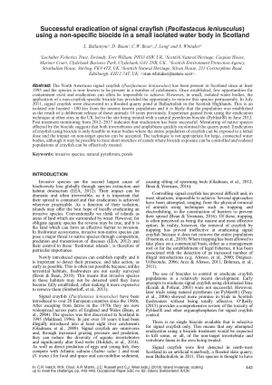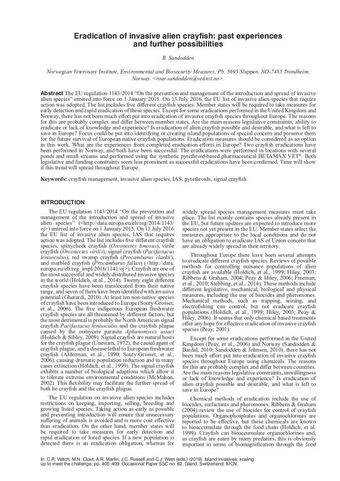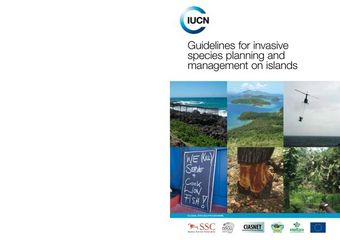Successful eradication of signal crayfish (Pacifastacus leniusculus) using a non-specific biocide in a small isolated water body in Scotland
- Description:
- The North American signal cray?sh (Pacifastacus leniusculus) has been present in Scotland since at least 1995 and the species is now known to be present in a number of catchments. Once established, few opportunities for containment exist and eradication can often be impossible to achieve. However, in small, isolated water bodies, the application of a non-cray?sh-speci?c biocide has provided the opportunity to remove this species permanently. In July 2011, signal cray?sh were discovered in a ?ooded quarry pond at Ballachulish in the Scottish Highlands. This is an isolated site located ~100 km from the nearest known population and it is likely that the population was established as the result of a deliberate release of these animals 10 years previously. Experience gained from using the eradication technique at other sites in the UK led to the site being treated with a natural pyrethrum biocide (Pyblast®) in June 2012. Post treatment monitoring from 20122017 indicates that eradication has been successful. Monitoring of native species a?ected by the biocide suggests that both invertebrates and amphibians quickly recolonised the quarry pond. Eradication of cray?sh using biocide is only feasible in water bodies where the entire population of cray?sh can be exposed to a lethal dose and the impact on non-target species can be accepted. The technique is not appropriate for large, connected water bodies, although it may be possible to treat short stretches of canals where biocide exposure can be controlled and isolated populations of cray?sh can be e?ectively treated.
- Display date:
- 2019
- Collections:
- Secretariat of the Pacific Regional Environment Programme (SPREP)
- Publisher:
- International Union for Nature Conservation (IUCN)
- Content partner:
- Secretariat of the Pacific Regional Environment Programme (SPREP)
- Availability:
- Not specified
-
Copyright status: All rights reservedFind out more about what you are able to do with this itemThis item is all rights reserved, with means you'll have to get permission from Secretariat of the Pacific Regional Environment Programme (SPREP) before using it. For more information, please see our use and reuse page.What can I do with this item?Non-infringing useNZ copyright law does not prevent every use of a copyright work, and this item may be hosted by an international institute or organisation. You should consider what you can and cannot do with a copyright work.No sharingYou may not copy and/or share this item with others without further permission. This includes posting it on your blog, using it in a presentation, or any other public use.No modifyingYou are not allowed to adapt or remix this item into any other works.No commercial useYou may not use this item commercially.
Related items
Welcome and warm Pasifik greetings
The information on this site has been gathered from our content partners.
The names, terms, and labels that we present on the site may contain images or voices of deceased persons and may also reflect the bias, norms, and perspective of the period of time in which they were created. We accept that these may not be appropriate today.
If you have any concerns or questions about an item, please contact us.



